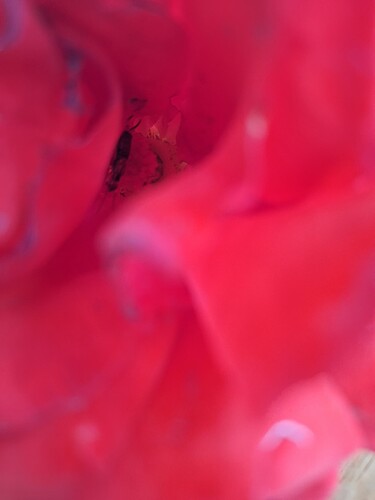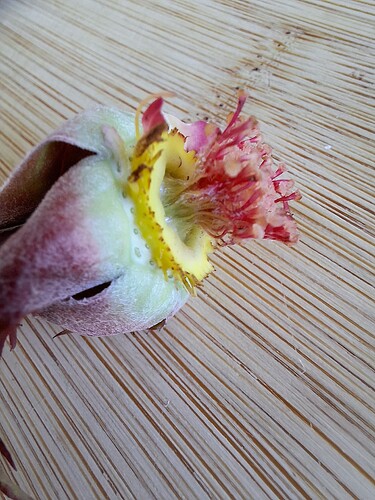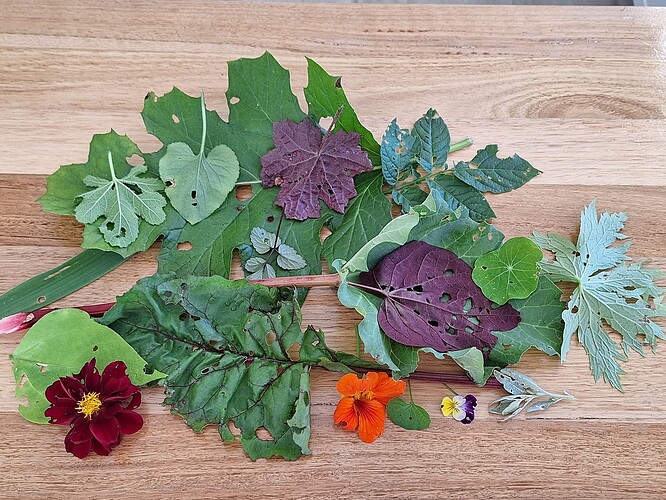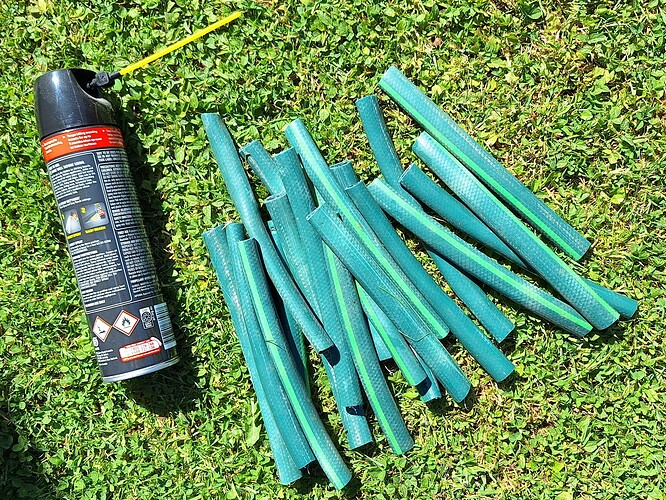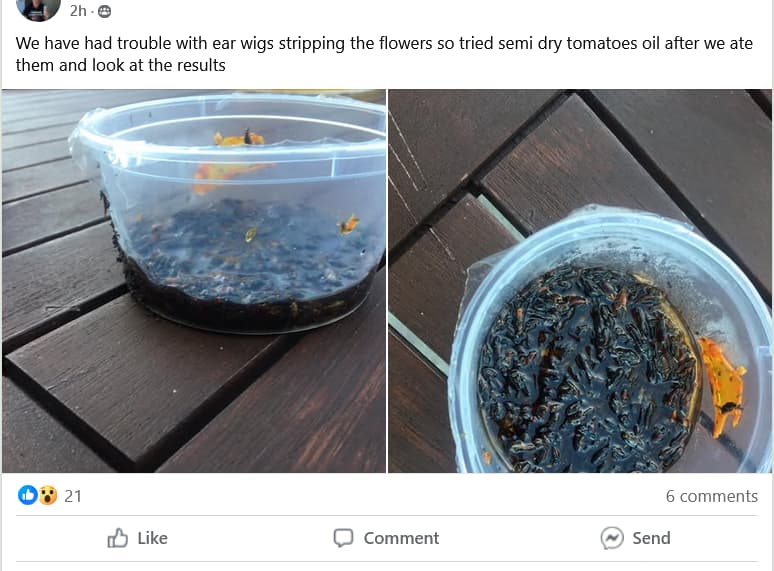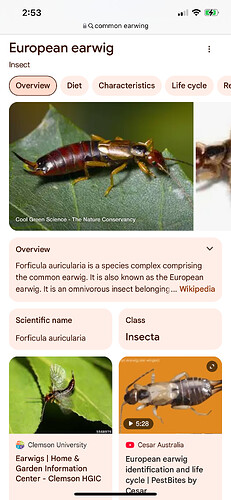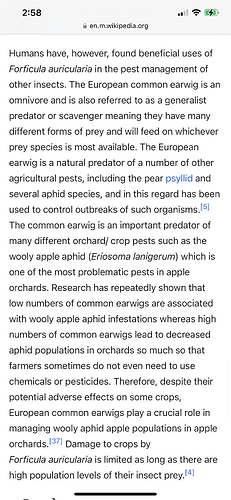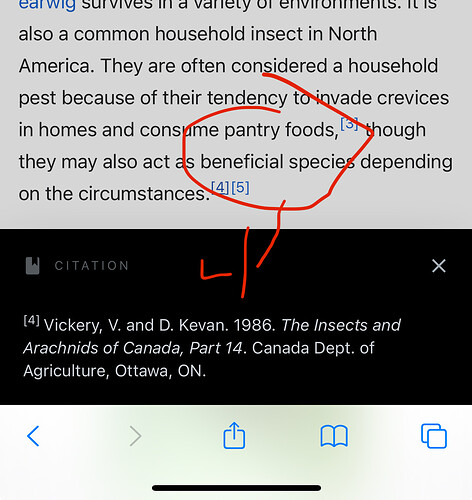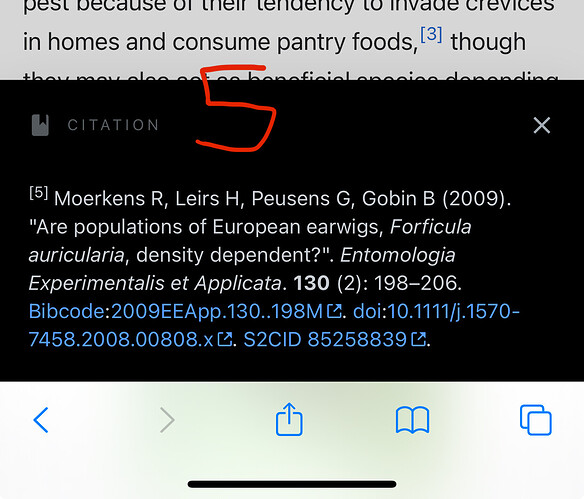My first crossing attempts and earwigs have gnawed off almost an entire crop of Fragrant Cloud stamens, is that a ‘thing’?
The same bloom, with (wind ravaged…) petals removed.
The yard is infested with the blighters, any suggestions regarding management/control most welcome. (Removing mulch during an Australian summer not really an option)
1 Like
I’ve seen stamens get devoured similarly here on occasion, but haven’t spotted the culprits. However, I’d normally harvest them for pollen or emasculate before the blossom has opened far enough for that to happen anyway, so there is never any real harm done as far as I’m concerned.
Stefan
1 Like
Damned earwigs!!
A cut flower dahlia grower friend of mine recommends using sections of old garden-hose cut into 9-12” lengths as catch traps for the foul insects, and just dumps the tubes out into hot soapy water every morning to cut down on earwig damage.
2 Likes
Stefan, thank you, but this is only one of the blooms - one into which I could see with the camera. I parted the enclosed heart of another two blooms and in one a blighter was scurrying hastily for the exit.
I believe earwigs carve circular holes into petals and leaves.
As I mentioned, infested…
However, in general the rose petals are in tact, at the moment with an obvious preference for the stamens, and taller/climbers appear to be safe for the time being.
1 Like
Oh yes, Dahlias are a particular fave in my yard as well! That is a fabulous tip. And I have just sidelined a leaking hose too!
1 Like
Stamens seem to be a favorite of many pests. I have something that resembles spotted cucumber beetles targeting any and every blossom I might hope to collect pollen from every year. I often have to harvest flowers and bring them inside to open to be able to collect pollen.
2 Likes
Round one…[to be sure, to be sure]
1 Like
Earwigs are beneficial overall even though they can cause or worsen damage on some plants. Simply seeing them on plants without a clear idea of what is happening could be misleading. Attempting to eradicate them is probably not a good idea, but taking measures to protect certain particularly vulnerable plants from them could be worthwhile. I wouldn’t be too bothered by some holes in leaves and petals, myself.
This popped up on a local gardening FBpage this morning:
I have tolerated them for a couple of years but infestations here a little bit out of the ordinary at the moment.
I will try a ‘barrier’ method on the Fragrant cloud by tying some sort of gauze/netting around the base (but still, any caught wil be doomed, sorry Stefan).
Oh dear. Earwigs poached in oil… yum?
I’ll definitely be curious to know if the carnage noticeably reduces the damage to your plants. They can cause occasional trouble with things like pomegranates here, and I suppose that if that ever escalated significantly, I might consider a gourmet death to be a relatively humane way of dealing with them.
1 Like
They are species that originated in Europe.
It makes sense that a pair of species native to the same continent would evolve together.
They’re still gross and super-creepy bugs, though. And when I consider the balance of the damage they do against the possible good they could serve (which if I’m doing gardening right should be well-served already by other, native species) I’ll manage their populations in areas and plants I find precious.
With this information I went down a rabbit hole, thank you Van.
I established that the European earwig does indeed occur in Tasmania, as an introduced species. It is a predator of the ‘woolly apple aphid’ (Tasmania is known as the ‘Apple Isle’ hence a favourable feral in this circumstance. Cherry orchardists not so gleeful, ditto citrus growers and grain/legume croppers on the mainland.)
Earwig diet (including a particular fondness for POLLEN  but thus deeming them to be ‘beneficial polinators’…) can include living and dead, plants and small animals, such as aphids, spiders and caterpillars, soft new plant tissue, soft skinned fruits, organic matter/detritis, fungi.
but thus deeming them to be ‘beneficial polinators’…) can include living and dead, plants and small animals, such as aphids, spiders and caterpillars, soft new plant tissue, soft skinned fruits, organic matter/detritis, fungi.
1 Like
Although the word ‘plague’ has been bandied about locally, my earwig infestion lives to fight another day. The ‘gourmet meals’ were fancied by another feral pest ‘plaguing’ my yard, European Blackbirds…
It does seem that oil trapping (I also see 50/50 oil and soy sauce blends being mentioned) is pretty widely recommended, and only has to be secured against the birds or other critters. Someone on Reddit mentions using containers with lids and holes punched that are just big enough for earwigs to enter, all buried up to the holes. I wonder if the soy sauce could be reduced, because I would be afraid of having that much salt getting sloshed or dumped near any plants if animals got into it (which they probably would, knowing the kind of wildlife we have around here).
I’ve spotted those blighters again, building up a new plague… Before the rose buds can be assaulted I am incorporating a barrier method into my strategy, in addition to the hose pieces. The mesh (and sticks, thorny rose twigs, netting, timber carpet strips armed with sharp tacks, groundcovers) is for another feral pest - European blackbirds. If they were actually effective in earwig control it would make navigating the garden a whole lot easier 
